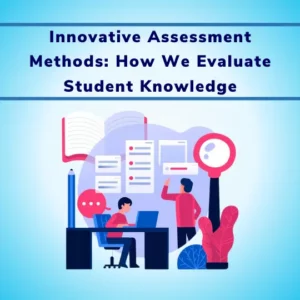Welcome to 2024, a year where classrooms and textbooks are getting a high-tech makeover!
In recent years the way people learn and the method of teaching has seen a drastic change. The modernization of the education sector led to the loss of all the old ways of learning and teaching. The star of this tech revolution?

You no longer go through 100 pages to find a particular text. A student can easily use AI tools like ChatGPT, BARD and more forms of generative AI to educate themselves. Teachers have found a way to make their classes more fun, research-based and interactive with the help of Generative AI.
The buzz surrounding Chat GPT in 2022 was just the tip of the iceberg. The transformative journey of generative AI within the education sector has seen a boost in 2023. In the present year, generative AI has become universally popular, permeating every aspect of the educational experience.
It has evolved into a versatile and intelligent assistant, akin to a digital companion that understands and caters to the unique needs of each learner.
This widespread integration is not merely about making learning more straightforward; it’s about infusing an element of enjoyment and personalisation into the educational journey.
AI has been utilized by 50% of Cambridge students in their university assignments.
Let’s explore how it alters the playing field for educators and learners.
Article Contents
Introduction
The educational landscape is changing dramatically as we approach the third decade of the twenty-first century. The aftermath of the online classes accelerated technology adoption in education, changing traditional classrooms into a new era.
The integration of technology in education is no longer an occasional experiment. It has become an essential element of how knowledge is imparted and acquired. Virtual classrooms, online collaboration tools, and digitized resources have become commonplace, reshaping the very essence of the educational experience.
Definition of Generative AI and Its Significance in Digital Transformation
A subclass of artificial intelligence known as “generative AI” deals with models that can produce fresh text, images, or other types of data. Unlike traditional AI, which relies on pre-existing data patterns, generative AI can create original content based on the information it has learned.
This technology marks a paradigm shift in the digital transformation of various sectors, including education.
Over 11% of academic papers globally, from colleges to schools, incorporate content generated by AI.
Some real-life scenarios where Generative AI is used are
A recent study by impact researchers showed that 60% of teachers are using ChatGPT, which is a 13% increase since February 2023. One-third of these teachers use ChatGPT for planning lessons and creating teaching materials. #0% of teachers use it to get creative ideas for their classes.
An additional 30% use it to learn more about different topics. This shows that more teachers find ChatGPT helpful in different aspects of their work.
Tutor AI is using generative AI to help with education. They have a special platform that creates fun and interactive lessons on many subjects.
Another way is for educational institutions to use chatbots. A report from Chatbot Life in 2019 says that education is the third-biggest area where chatbots are helpful.
I. Understanding Generative AI
A. What is Generative AI?
Generative AI is a subset of artificial intelligence designed to create new content autonomously. Unlike conventional AI, which relies on predefined data patterns, generative AI leverages sophisticated algorithms and neural networks to generate original material, such as text, images, or other data forms.
Its ability to autonomously produce novel content makes it a powerful tool across various sectors, from creative applications to educational advancements.
Teachers are using Generative AI tools just as much as students. A 2023 survey by the Walton Family Foundation and impact researchers found that 51% of teachers used ChatGPT within two months of its introduction. On the other hand, only 22% of students used it weekly. Interestingly, 64% of teachers plan to use ChatGPT more often in the future.
B. How does it work?
Generative AI operates through advanced neural networks, such as Generative Adversarial Networks (GANs) or transformers. These models are trained on vast datasets, learning intricate patterns and relationships within the data.
During the generation process, the AI receives a prompt or input and utilizes its learned knowledge to autonomously create new content. GANs, for example, consist of a generator creating content and a discriminator evaluating its authenticity, fostering a dynamic learning loop.
C. Differences between Generative AI and other forms of AI.
Generative AI sets itself apart from other forms of artificial intelligence by its unique ability to create new content rather than relying solely on predefined patterns.
Unlike traditional AI, which primarily operates through rule-based algorithms, generative AI leverages complex neural networks, enabling it to autonomously generate diverse and original outputs.
Numerous forms of AI exist, ranging from Traditional AI to Generative AI, each tailored for specific objectives and applications. Let us see some of their differences.
Comparison with Other Forms of AI:
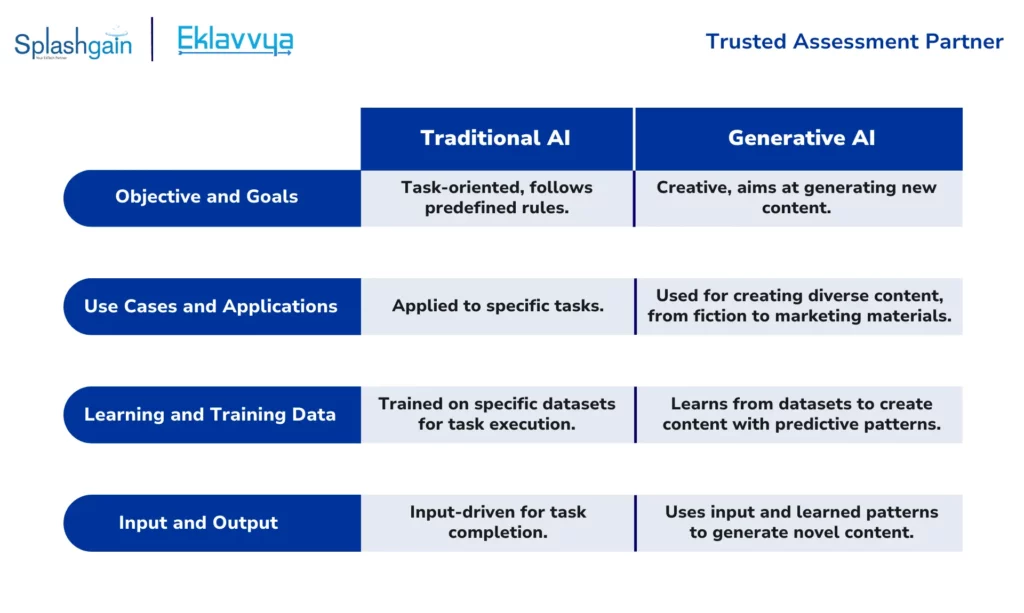
– Objectives and Goals:
- Traditional AI: Task-oriented, follows predefined rules.
- Generative AI: Creative, aims at generating new content.
– Use Cases and Applications:
- Traditional AI: Applied to specific tasks.
- Generative AI: Used for creating diverse content, from fiction to marketing materials.
– Learning and Training Data:
- Traditional AI: Trained on specific datasets for task execution.
- Generative AI: Learns from various datasets to create content with predictive patterns.
– Input and Output:
- Traditional AI: Input-driven for task completion.
- Generative AI: Uses input and learned patterns to generate novel content.
Conversational AI vs. Generative AI:
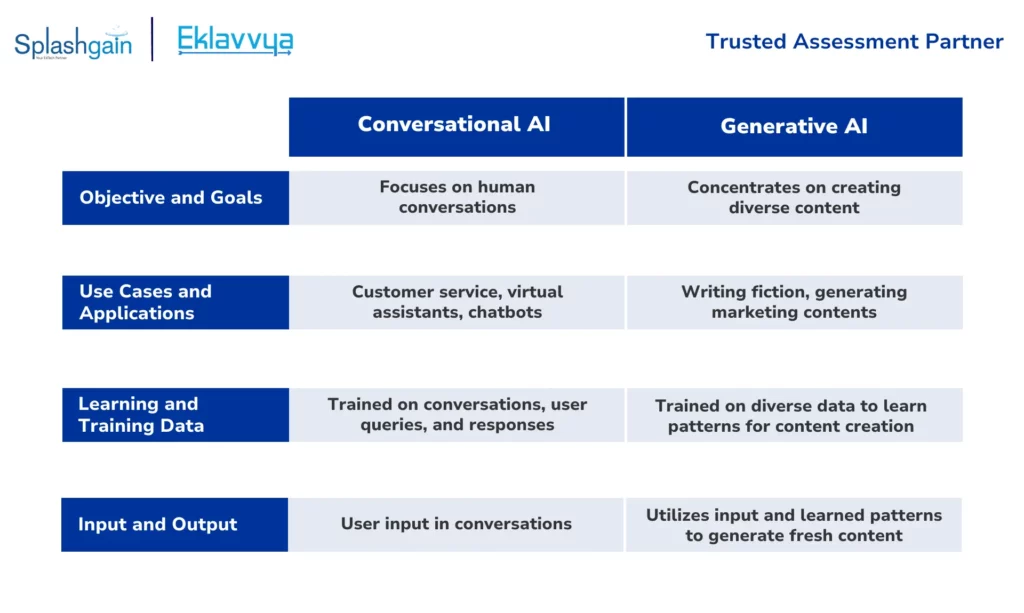
– Objectives and Goals:
- Conversational AI: Focuses on human conversations.
- Generative AI: Concentrates on creating diverse content.
– Use Cases and Applications:
- Conversational AI: Customer service, virtual assistants, chatbots.
- Generative AI: Writing fiction, generating marketing content, crafting meta descriptions.
– Learning and Training Data:
- Conversational AI: Trained on conversations, user queries, and responses.
- Generative AI: Trained on diverse data to learn patterns for content creation.
– Input and Output:
- Conversational AI: User input in conversations.
- Generative AI: Utilizes input and learned patterns to generate fresh content.

II. The Evolution of Generative AI
A. Brief History and Advancements in Generative AI:
The evolution of Generative AI traces back to the early development of neural networks and machine learning. Notable milestones include the introduction of Restricted Boltzmann Machines in the 1980s and the emergence of deep learning architectures in the 2010s.
However, the breakthrough came with the advent of Generative Adversarial Networks (GANs) in 2014 by Ian Goodfellow and his team.
B. Current Capabilities and Limitations:
In 2024, Generative AI will exhibit remarkable capabilities across various domains. It excels in generating high-quality, contextually relevant content, from realistic images to coherent text. In the educational realm, it tailors learning materials, aids in exam creation, and provides personalized feedback.
However, challenges persist. Ethical concerns regarding bias in generated content and potential misuse necessitate scrutiny.
$239,3 billion is the predictive value of the e-learning market by 2027.
Potential for cross-industry applications
Generative AI’s versatility extends beyond education, finding profound applications across diverse industries. In the education sector, generative AI helps in designing courses, personalized lessons, and content creation for courses. It is also applicable in restoring old material of courses, adaptive testing and predictive analysis. This helps both teachers and students in many ways.
One out of every three college students in the US relies on ChatGPT for their homework assignments.
III. Generative AI in Academic Document Verification/Scrutiny
A. Streamlining Admission Processes
Automated Verification of Academic Credentials:
Generative AI has become instrumental in streamlining the verification of academic credentials and revolutionizing the admissions process in educational institutions. By harnessing the power of sophisticated algorithms, Generative AI facilitates the quick and accurate verification of academic qualifications.
This automation significantly expedites the traditionally time-consuming manual verification procedures, allowing institutions to efficiently assess and admit qualified candidates.
Detection of Fraudulent Documents:
Generative AI serves as a formidable tool in enhancing the integrity of academic environments by detecting fraudulent documents. Through advanced pattern recognition and analysis, the AI scrutinizes documents submitted during the admission process, identifying anomalies or inconsistencies that may indicate forgery. This capability is crucial in maintaining the credibility of academic institutions, safeguarding against the submission of false qualifications.
B. Enhancing Research Integrity
Cross-referencing Research Papers for Originality:
Generative AI has emerged as a powerful tool for upholding research integrity by cross-referencing research papers for originality. With the ability to analyze vast datasets and understand complex linguistic patterns, Generative AI can identify similarities and dissimilarities between research papers. This process ensures that academic work is genuine and contributes to the body of knowledge.
Plagiarism Checks and Citation Verification:
Generative AI is pivotal in conducting thorough plagiarism checks and citation verification. Through its advanced natural language processing capabilities, it compares the submitted work with an extensive database of academic content, identifying instances of plagiarism or inadequate citation. This not only safeguards the academic integrity of scholarly publications but also promotes responsible research practices.

IV. Generative AI in the Examination Process
A. Automated Test Generation
Creating Unique Test Questions and Formats:
Generative AI has revolutionized the realm of education by automating the process of creating unique test questions and formats. By leveraging sophisticated algorithms, it generates diverse and contextually relevant questions that challenge students’ understanding and application of knowledge.
This innovation goes beyond traditional methods, ensuring that each test is tailored to the specific content covered and the learning objectives.
Adapting Difficulty Based on Student Performance:
Generative AI’s adaptive capabilities are harnessed to tailor the difficulty of test questions based on individual student performance. By analyzing real-time data during assessments, the AI adjusts the level of difficulty to match the student’s proficiency.
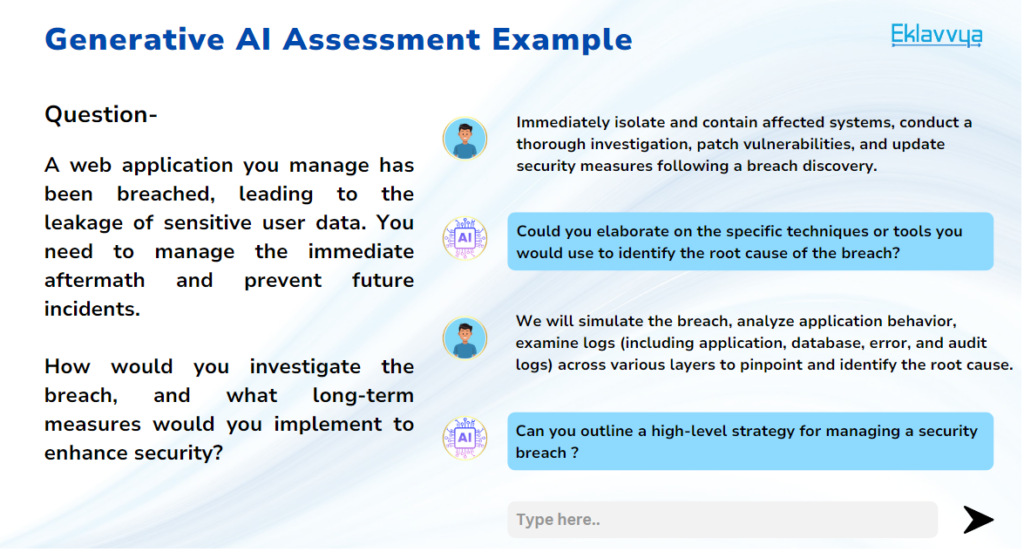
This adaptive approach ensures that each student is appropriately challenged, providing an accurate reflection of their understanding and preventing unnecessary frustration or boredom.
The personalized difficulty adaptation enhances the precision of assessments, allowing educators to gauge student competence more accurately. This dynamic and responsive testing model not only promotes fairness but also contributes to a more supportive and individualized learning experience, showcasing Generative AI’s transformative impact on educational assessment practices.
B. Monitoring and Proctoring
AI-driven proctoring systems for remote examinations.
AI-driven proctoring systems use facial recognition, eye-tracking, and behaviour analysis to monitor students during remote examinations, ensuring testing integrity. By replicating traditional exam supervision in virtual settings, these systems deter cheating, maintain fairness, and uphold the credibility of remote assessments in educational environments.
Ensuring fairness and integrity in the testing environment.
Ensuring fairness and integrity in the testing environment involves implementing rigorous measures, such as AI-driven proctoring systems. These technologies monitor and analyze student behaviour during exams, deterring cheating and safeguarding the credibility of assessments, whether conducted in-person or remotely.
V. Generative AI for Providing Personalized Feedback to Students
A. Individualized Learning Assessments
Tailored feedback on student assignments and tests.
Generative AI provides tailored feedback on student assignments and tests by analyzing individual responses. This personalized feedback helps students understand their strengths and areas for improvement, fostering a more effective learning experience and encouraging continuous academic growth.
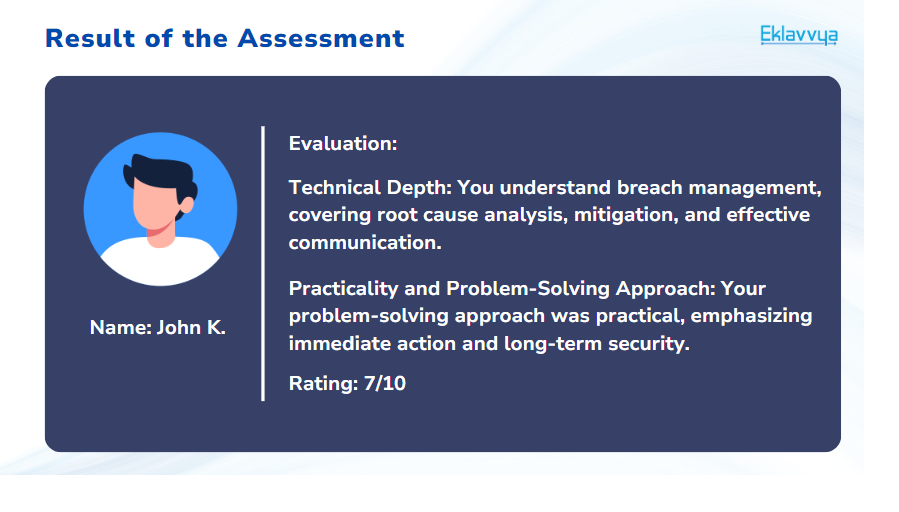
Identifying areas of strength and improvement for each student.
Generative AI identifies areas of strength and improvement for each student by analyzing their performance data. This personalized approach allows educators to offer targeted guidance, enabling students to leverage their strengths and address specific areas that require enhancement. As a result, it contributes to individualized and effective learning experiences.
B. Adaptive Learning Platforms
Dynamic adjustment of course content based on feedback.
Generative AI facilitates the dynamic adjustment of course content based on feedback. By analyzing student interactions and performance data, the system adapts the curriculum in real-time. This ensures that the learning material remains relevant, engaging, and tailored to meet the evolving needs and preferences of the students.
Personalized learning experiences at scale.
Generative AI enables personalized learning experiences at scale by dynamically adapting course content. This scalable approach tailors educational materials to individual students, fostering engagement and addressing diverse learning styles.
It revolutionizes education by providing a customized and efficient learning journey for a large and varied student population.
VI. Generative AI for Training Course Effectiveness
A. Course Design and Improvement
Data-driven insights into course engagement and effectiveness.
Generative AI provides data-driven insights into course engagement and effectiveness by analyzing student interactions. This information allows educators to assess the impact of their teaching strategies, optimize course content, and enhance overall learning experiences, ensuring that educational initiatives are continuously refined for maximum effectiveness.
Iterative course content development based on student feedback.
Generative AI supports iterative course content development by incorporating real-time student feedback. This dynamic process allows educators to adjust and refine the curriculum continuously, ensuring it aligns with student needs and preferences. It creates a responsive learning environment that evolves based on the insights gathered from student experiences.
B. Teacher and Trainer Assistance
AI as a support tool for educators in course planning.
AI is a valuable support tool for educators in course planning by analyzing data on student performance and learning patterns. This assists educators in tailoring curriculum content to meet individual needs, optimizing teaching strategies, and fostering a more effective and adaptive approach to course design.
Real-time suggestions for teaching strategies and classroom management.
Generative AI provides real-time suggestions for teaching strategies and classroom management by analyzing ongoing classroom dynamics. It offers immediate insights to educators, helping them adapt their teaching methods and manage the learning environment effectively. This dynamic support enhances the overall quality and responsiveness of the educational experience.

Conclusion
Generative AI presents a transformative paradigm in education, reshaping how knowledge is imparted and absorbed. From automated exam creation to personalized learning experiences, its impact is profound. It tailors education, providing dynamic content, feedback, and assessments, fostering an adaptive and engaging learning environment.
Achieving a harmonious balance between AI assistance and human oversight is crucial. While AI enhances efficiency and personalization, human educators bring empathy, context, and a nuanced understanding. Collaboration between AI and educators ensures a holistic approach, leveraging the strengths of both for an enriched educational experience.
As AI embeds itself deeper into education, ethical considerations loom large. Privacy, bias, and transparency demand vigilant attention. Striking the right ethical balance requires robust guidelines and open discourse.
The future of AI in education holds immense promise, but its trajectory must be guided by ethical principles to ensure equity, fairness, and a positive impact on the learning journey. Embracing AI responsibly is not just a choice; it’s a commitment to shaping an inclusive and ethically sound future for education.


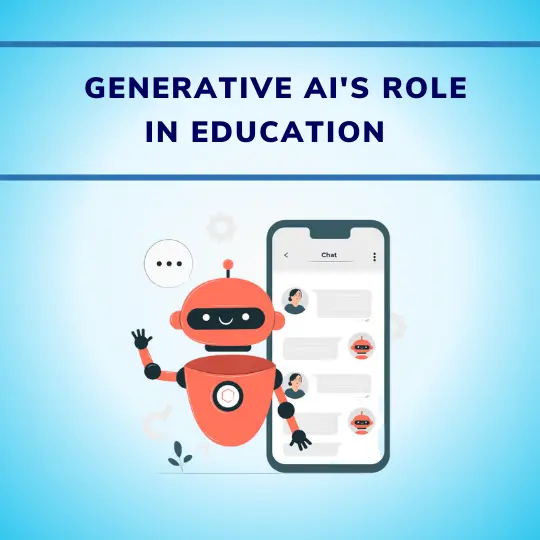
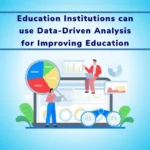
![How Government-Led Exams at 250+ Locations Are Setting New Standards of Integrity [Case Study]](https://www.eklavvya.com/blog/wp-content/uploads/2024/04/Enhancing-Exam-Integrity-Government-Certification-in-250-Locations-150x150.webp)
![Transforming Central Govt. Exams Evaluation: How Onscreen Marking is Leading the Charge [Case Study]](https://www.eklavvya.com/blog/wp-content/uploads/2024/04/How-Onscreen-Marking-Revolutionized-Central-Govt-Exams-Case-Study-1-150x150.webp)
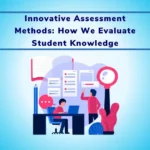
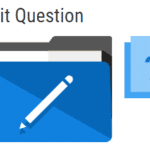

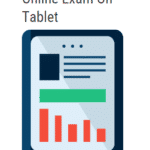









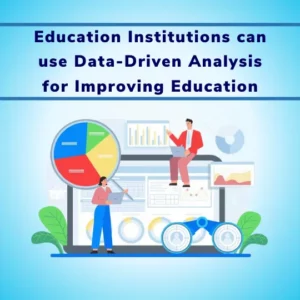

![How Onscreen Marking Revolutionized Central Govt Exams [Case Study]](https://www.eklavvya.com/blog/wp-content/uploads/2024/04/How-Onscreen-Marking-Revolutionized-Central-Govt-Exams-Case-Study-1-300x300.webp)
